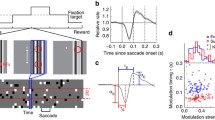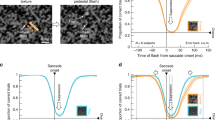Abstract
The effect of saccadic eye movements on threshold perception is investigated theoretically. The proposed model considers eye movements by taking into account the shifting of the stimulus pattern on the retina during the occurrence of an eye movement. Saccades are characterized by high velocity and short duration. These motions cause overshoots in the response of linear filters to certain stimulus patterns. Therefore, the model predicts facilitation effects of saccades in the perception of low spatial frequency patterns and patterns flickering with high temporal frequencies. These results agree with experimentally obtained data presented in a subsequent paper. A simple approach is formulated which approximates the complex shifting function of a saccade by a switching of the pattern.
Similar content being viewed by others
References
Breitmeyer BG (1980) Unmasking visual masking: a look at the “why” behind the weil of the “how”. Psych Rev 87:52–69
Budriskis ZL (1973) Model approximations to visual spatio temporal sine-wave threshold data. Bell Syst Tech J 52:1643–1677
Deubel H, Elsner T (1986) Threshold perception and saccadic eye movements. Biol Cybern 54:351–358
Elsner T (1982) Spatial and temporal modeling of visual threshold detection. Perception 11: A35
Hauske G, Deubel H (1984) Temporal responses to switched and saccade induced flicker modulation onsets. Invest Ophthalmol 25:70
Hofer-Alfeis J (1982) Entzerrung linienhafter Verwischung zur Bildrekonstruktion aus Projektionen. Doctoral Thesis, TU München
Kelly DH (1979) Motion and vision. II. Stabilized spatiotemporal threshold surface. J Opt Soc Am 69:1340–1349
Koenderink JJ, van Doorn AJ (1979) Spatiotemporal contrast detection threshold surface is bimodal. Opt Lett 4:32–34
Levinson JZ (1968) Flicker fusion phenomena. Science 160:21–28
Lupp U (1981) Systemtheoretische Analyse der zeitlichen Einschwingvorgänge im visuellen System. Doctoral Thesis, TU München
Lupp U, Hauske G, Wolf W (1978) Different systems for the visual detection of high and low spatial frequencies. Photogr Sci Eng 22:80–84 (1978)
Marko H (1981) The z-model — a proposal for spatial and temporal modeling of visual threshold perception. Biol Cybern 39:111–113
Roufs JA (1974) Dynamic properties of vision. VI. Stochastic threshold fluctuations and their effect on flash-to-flicker sensitivity ratio. Vision Res 14:871–888
Roufs JA, Blommaert FJJ (1981) Temporal impulse and step responses of the human eye obtained psychophysically by means of a drift-correcting perturbation technique. Vision Res 21:1203–122
Tulunay-Keesy, U, Jones RM (1976) The effect of micro movements of the eye and exposure duration on contrast sensitivity. Vision Res 16:481–488
Author information
Authors and Affiliations
Rights and permissions
About this article
Cite this article
Elsner, T., Deubel, H. The effect of saccades on threshold perception — A model study. Biol. Cybern. 54, 359–366 (1986). https://doi.org/10.1007/BF00355541
Received:
Issue Date:
DOI: https://doi.org/10.1007/BF00355541




